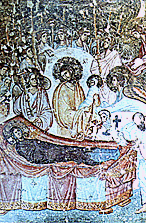 |
|
 |
Sopocani - Church of the Holy Trinity
 he church of the Holy Trinity at
he church of the Holy Trinity at
 Sopocani in Serbia is adorned with an important painting ensemble, which is considered as the ultimate creation of the Byzantine painting of the 13th century, but also as one of the artistic masterpieces of the world. The
katholikon
was founded around 1260 by the
krajl
Stefan Uros I
as a mausoleum of the Serbian ruling family, while its painted decoration is dated to between 1263 and 1268. The typical
iconographic programme
is enriched here with representations in the sanctuary of the Divine Liturgy and scenes from the Old Testament in the naos (main part of the church). On the west wall is depicted the Koimesis (Dormition of the Virgin), which is the most important scene of this painting ensemble, while particularly interesting is the portrait of the donor and his family. The practice of including donors or founders of a church among the figures represented in its frescoes was widespread during the Late Byzantine period and it is typical in Serbian monuments. The wall paintings at Sopocani are, according to some scholars, the climactic point of the stylistic tendency which is inspired by the Classical tradition and is known as the first Palaiologan style. Characteristics features of this style are the plastic and monumental rendering of the figures and composition. The sense of three-dimensional space, the modelling of the faces, achieved only with colour and without the use of lines, the forms, the robust figures treading realistically on the pictorial ground, the warm colours of the garments, which envelop the forms in an ethereal way, are some of the artistic features of this important monumental ensemble. Sopocani in Serbia is adorned with an important painting ensemble, which is considered as the ultimate creation of the Byzantine painting of the 13th century, but also as one of the artistic masterpieces of the world. The
katholikon
was founded around 1260 by the
krajl
Stefan Uros I
as a mausoleum of the Serbian ruling family, while its painted decoration is dated to between 1263 and 1268. The typical
iconographic programme
is enriched here with representations in the sanctuary of the Divine Liturgy and scenes from the Old Testament in the naos (main part of the church). On the west wall is depicted the Koimesis (Dormition of the Virgin), which is the most important scene of this painting ensemble, while particularly interesting is the portrait of the donor and his family. The practice of including donors or founders of a church among the figures represented in its frescoes was widespread during the Late Byzantine period and it is typical in Serbian monuments. The wall paintings at Sopocani are, according to some scholars, the climactic point of the stylistic tendency which is inspired by the Classical tradition and is known as the first Palaiologan style. Characteristics features of this style are the plastic and monumental rendering of the figures and composition. The sense of three-dimensional space, the modelling of the faces, achieved only with colour and without the use of lines, the forms, the robust figures treading realistically on the pictorial ground, the warm colours of the garments, which envelop the forms in an ethereal way, are some of the artistic features of this important monumental ensemble.
|